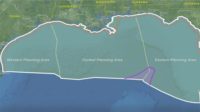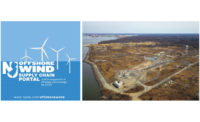Heavy lift helicopters are saving time and money in New Jersey for a public utility that’s building new electricity lines over water.
The teams building four Atlantic City Electric projects, worth $129 million total, to enhance grid resilience are using the aircraft to place wind-resistant lines across miles of marshland and to transport construction workers over environmentally sensitive areas that normally would be destroyed or damaged by trucks and heavy equipment.
The first project, a $46 million upgrade of a major transmission line off of Absecon Island, was completed in April.
“This is the first time it (a helicopter) was used in marshland construction with PyraMAX transmission towers,” says Gordon Dennis, senior project manager for engineering and construction firm Henkels & McCoy Inc., which provided installation and construction of the transmissions poles, towers and lines as well as demolition and removal of the existing system.
The team used Sikorsky S-64 Skycranes: twin-engine, heavy lift helicopters fly in and install steel used for three 69,000-volt transmission lines that go into Atlantic City, and to remove older wooden poles in marshlands and replace them with the PyraMAX towers.
Dan Loveland, director of project management for Atlantic City Electric and Delmarva Power, says the team saved $2.5 million on the project by “not having to do extensive restoration work to the marshland,” which “would have been hundreds of thousands of dollars,” as well as by reducing scheduled work time and "reducing the possibility of expensive repairs.” He adds that the helicopters cut the work schedule down by “more than a month.”
Three more utility projects, together worth about $83 million, are scheduled to start construction in the fall, Loveland says. Two in Cape May County are out to bid, and another that spans both Atlantic and Ocean counties goes to bid in July.
PyraMAX towers require no structural testing and “you can implement them where terrain presents challenges,” Dennis says, but they’re still difficult to install by helicopter.
Each tower “requires four structural support foundation, and these foundations must be set with extreme precision with tolerances less than one inch. This is difficult – or nearly impossible - to do with a helicopter installing overhead to achieve this," Dennis says.
The structures were set on driven caissons that are 60 ft deep and set 16 ft apart, Loveland says. Contractors and engineering consultants worked together to develop a template that weighed 18,000 pounds, creating a way to allow caissons to be set from the helicopter.
"It was like something out of a James Bond film,” he says.
The team also “moved mechanics on a long line. They were harnessed in and moved out to the job site,” Loveland says. “It’s an approach that’s used often in mountains, but in this case, it was used because of environmental sensitivity.”
Human external cargo helicopters transported crew members, who rode on bosun’s chairs hanging underneath, to the site.
“We had a fly yard where we stationed the helicopters out of and the men would be transported by the smaller helicopters to the marshland areas from the fly yard,” Dennis explains.
Use of the aircraft helped preserve species that live on Absecon Island, including ospreys, bald eagles, Eastern meadowlarks, horned larks and killdeer, which breed in spring and summer.
“Doing the work from a helicopter, we don’t have to send cranes and trucks and workers [that could] destroy the marshland,” Dennis says. “We had short time to do the installation because of bird migration and by using the helicopters, we were able to reduce the time frame greatly on the job and have zero environmental impacts.”
As essential utility projects, the grid upgrades were exempt from New Jersey’s COVID-19 shutdowns, which lasted from April 10 to May 18. Dennis says the pandemic caused minor issues “because we were unable to have face-to-face meetings,” but “it was just a minor hiccup.”
The completed and planned upgrades will improve power reliability in southern New Jersey, which is susceptible to hurricanes, says Tyler Anthony, senior vice president and chief operating officer of Pepco Holdings, a unit of Exelon Corp., which oversees the operation of Atlantic City Electric.
Loveland said the new metal towers can withstand winds of up to 120 mph. They were tested within a week of being put into service – by 90-mph straight line winds, called derechos, which swept through Atlantic County to the beach June 3.




Post a comment to this article
Report Abusive Comment